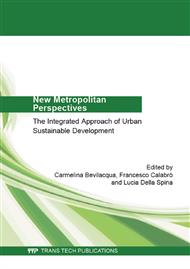[1]
R. Paparelli and M. Del Duca: Centri commerciali naturali. Strategia e strumenti di network marketing a servizio del commercio, del turismo e del terziario. Milano: Franco Angeli (2010).
Google Scholar
[2]
F. D. Moccia and A. Sgobbo: La polarizzazione metropolitana. L'evoluzione della rete della grande distribuzione verso un sistema policentrico sostenibile. Napoli: Liguori Editore (2013).
Google Scholar
[3]
S. Zukin: The Cultures of Cities. Oxford: Basil Blackwell (1995).
Google Scholar
[4]
A. Loukaitou-Sideris: Revisiting inner-city strips: A framework for community and economic development, Econ. Dev. Q., vol. 14, no. 2, (2000), p.165–181.
DOI: 10.1177/089124240001400204
Google Scholar
[5]
S. Halebsky: Superstores and the politics of retail development, City Community, vol. 3, no. 2, p.115–134, (2004).
DOI: 10.1111/j.1535-6841.2004.00072.x
Google Scholar
[6]
M. Lowe: The regional shopping centre in the inner city: a study of retail-led urban regeneration, Urban Stud., vol. 42, no. 3, (2005), p.449–470.
DOI: 10.1080/00420980500035139
Google Scholar
[7]
M. Sansone: Confronti metodologici , riflessioni critiche e proposte operative sul Marketing Urbano in ambito internazionale: focus sull'organizzazione e gestione dei Centri Commerciali Naturali in Italia, in Marketing Trends, 2007, vol. 58, no. (1996).
Google Scholar
[8]
J. Jacobs: The Death and Life of Great American Cities, vol. 71. (1961), p.458.
Google Scholar
[9]
R. Oldenburg: The great good place: Cafés, coffee shops, community centers, beauty parlors, general stores, bars, hangouts, and how they get you through the day. New York: Paragon House, (1989).
DOI: 10.1086/sharevv23n1p19
Google Scholar
[10]
L. Zanderighi: Town Centre Management: uno strumento innovativo per la valorizzazione del centro storico e del commercio urbano, Ind. Distrib., no. 2, (2001).
Google Scholar
[11]
S. Carr, M. Francis, L. G. Rivlin, and A. M. Stone: Needs in public space, in Public Space, Cambridge: Cambridge University Press (1992).
Google Scholar
[12]
G. Esposito De Vita, C. Trillo, and S. Oppido: Rigenerazione degli spazi pubblici e centri commerciali naturali: il caso di Piazza Mercato e Borgo Orefici a Napoli, Planum, no. 26, (2013).
Google Scholar
[13]
K. Seidman: Inner-city commercial revitalization: A literature review, Boston (2004).
Google Scholar
[14]
B. Secchi: Un'urbanistica di spazi aperti, Casabella, vol. 597, no. 598, (1993), p.5.
Google Scholar
[15]
National Institute for Distribution and Services., [Online]. Information on http: /www. indisunioncamere. it.
Google Scholar
[16]
M. Cremaschi: Sul disagio urbano, Arch. di Stud. urbani e Reg., (2001).
Google Scholar
[17]
K. Chapple and R. Jacobus: Retail trade as a route to neighborhood revitalization, Urban Reg. policy its Eff., vol. 2, (2009), p.19–68.
Google Scholar
[18]
S. A. Sutton: Rethinking commercial revitalization: A neighborhood small business perspective, Econ. Dev. Q., vol. 24, no. 4, (2010), p.352–371.
DOI: 10.1177/0891242410370679
Google Scholar
[19]
J. A. Coca-Stefaniak, C. Parker, S. Quin, R. Rinaldi, and J. Byrom: Town centre management models: A European perspective, Cities, vol. 26, no. 2, (2009), p.74–80.
DOI: 10.1016/j.cities.2008.12.001
Google Scholar
[20]
M. Ricci and P. Valentino: A focus on CCN in Italy: an integrated approach among urban renewal and PPP, in FIRST SCIENTIFIC REPORT 2012 CLUDs PROJECT - Economic Development Strategies. The role of Public Private Partnership, (2012).
Google Scholar
[21]
R. Atkinson: Addressing urban social exclusion through community involvement in urban regeneration, in Urban Renaissance? New Labour, Community and Urban Policy, Bristol: Policy Press, (2003), p.101–119.
DOI: 10.46692/9781847425706.006
Google Scholar
[22]
P. Avarello and M. Ricci: edited by, Politiche urbane: dai programmi complessi alle politiche integrate di sviluppo urbano, INU. Roma: INU (2000).
Google Scholar
[23]
A. Magnaghi: Il progetto locale. Torino: Bollati Boringhieri (2000).
Google Scholar
[24]
Information on http: /urbact. eu.
Google Scholar
[25]
S. Zamagni: L'economia del bene comune, vol. 3. Città nuova (2007).
Google Scholar
[26]
D. J. Wright: It takes a neighbourhood: Strategies to prevent urban decline. Rockefeller Institute (2001).
Google Scholar
[27]
A. W. Dyer: Credit access and urban regeneration in the United States, in FIRST SCIENTIFIC REPORT 2012 CLUDs PROJECT - Economic Development Strategies. The role of Public Private Partnership, (2012).
Google Scholar
[28]
Information on http: /www. cluds-7fp. unirc. it.
Google Scholar
[29]
Network CLUDs, FIRST SCIENTIFIC REPORT 2012 CLUDs PROJECT - Economic Development Strategies. The role of Public Private Partnership, (2012).
Google Scholar
[30]
A. Etzioni: The new golden rule: Community and morality in a democratic society. Basic Books (1996).
Google Scholar
[31]
B. Secchi: Prima lezione di urbanistica. Roma: Laterza (2002).
Google Scholar
[32]
J. B. Cullingworth: British land-use planning: a failure to cope with change?, Urban Stud., vol. 34, no. 5–6, (1997), p.945–960.
DOI: 10.1080/0042098975907
Google Scholar
[33]
G. Esposito De Vita, C. Trillo, C. Bevilacqua, and A. L. Schultz: Boosting the link between enterprises promotion and heritage valorisation: towards an integrated approach to urban regeneration and tourism development, in Competition and innovation in tourism: new challenges in an uncertain environment, A. Morvillo, edited by, Napoli: Enzo Albano Editore, (2012).
Google Scholar
[34]
R. K. Yin: Case study research: Design and methods, vol. 5. Londra: Sage (2009).
Google Scholar
[35]
G. Esposito De Vita, C. Bevilacqua, and C. Trillo: Improving Conviviality in Public Places: the case of Naples, Italy, " J. Civ. Eng. Archit., vol. 7, (2013), p.1209–1219.
DOI: 10.17265/1934-7359/2013.10.004
Google Scholar


